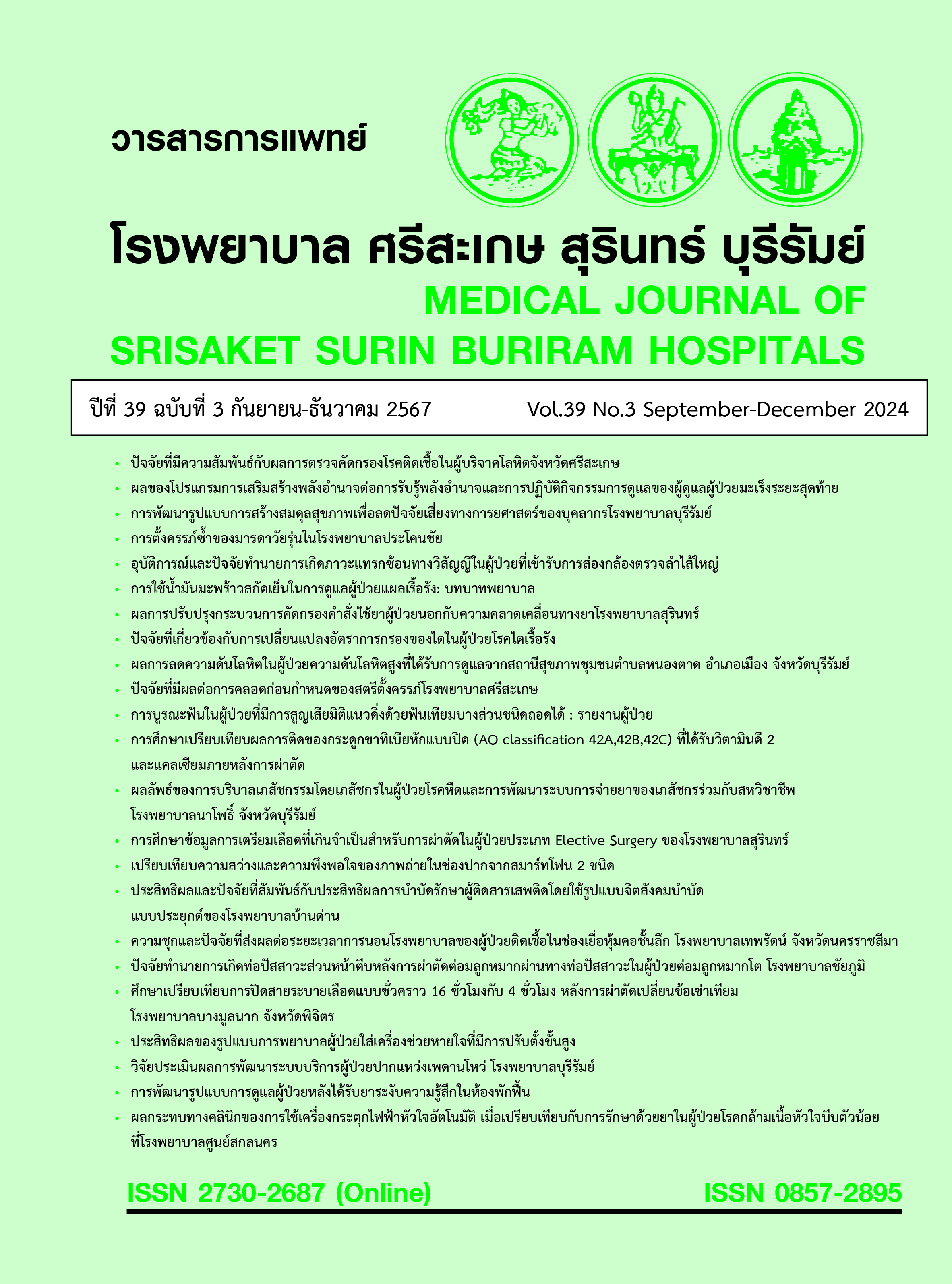The Effectiveness of a Nursing Care Model for Ventilated Patients with Advanced Adjustment Settings
Main Article Content
Abstract
Background: Patients with Acute Respiratory Distress Syndrome (ARDS) who require mechanical ventilation require physicians to make advanced ventilator settings, which differ from standard adjustments and involve complex management. Physicians need to administer sedatives, and in some cases, muscle relaxants are also needed, leading to a reduced level of consciousness in the patients. Nurses must provide close monitoring to ensure their safety and prevent potential complications. Therefore, it is essential to develop a nursing care model for this group of patients.
Objective: To develop a nursing care model for patients on advanced ventilator settings and to study the effectiveness of a nursing care model for patients on advanced ventilator settings in the medical intensive care unit at Surin Hospital.
Methods: This action research was conducted in three phases: 1) situational analysis, 2) the development and implementation of the care model, and 3) evaluation of the outcomes. A purposive sampling method included 22 service providers and 65 service recipients, with ethical approval from the ethics committee of Surin Hospital. The instruments used to assess the quality were validated by three experts, including in-depth interviews with physicians, focus group discussions with professional nurses in the intensive care unit, compliance record forms, medical record review forms, and satisfaction surveys. The data were analyzed using content analysis. Statistical analysis involved the use of percentages, means, and standard deviations. For comparative analysis, the Fisher Exact Test was used.
Results: 1. The nursing care model for patients on advanced ventilator settings consists of 8 key components: recording ventilator settings, assessing ventilator monitoring values, adjusting sedative and muscle relaxant doses, evaluating the patient's level of consciousness, positioning the patient in the prone position, nursing care during physician-administered high-pressure lung expansion, and criteria for reporting to the physicians. 2. The results of using the nursing care model for patients on advanced ventilator settings revealed that in recording ventilator settings, nurses were able to adjust the oxygen levels according to the physician's specifications at a rate of 100%. For assessing ventilator monitoring values, the frequency of ventilator monitoring assessments was increased from every 4 hours to every 1 hour at a rate of 100%. Physicians adjusted sedative and muscle relaxant doses based on the nurses' assessments of the patient's level of consciousness a rate of 100%. In positioning patients in the prone position, the incidence of cervical spine injury was zero. When comparing before and after using the model, no correlation was found between the care model and cervical spine injury. Additionally, the incidence of pneumothorax during high-pressure lung expansion by the physicians was also zero. When comparing before and after using the model, a statistically significant relationship was found in the expected direction, where the group receiving traditional care had a higher likelihood of developing pneumothorax compared to those receiving care with the model, with statistical significance at the 0.05 level (p < 0.05). Nurses reported to the physicians when there was indicated by the established criteria at the rate of 100%. Both physicians and nurses expressed high satisfaction with the model.
Conclusion: The nursing care model for patients on advanced ventilator settings resulted in a reduction in the incidence of pneumothorax.
Article Details

This work is licensed under a Creative Commons Attribution-NonCommercial-NoDerivatives 4.0 International License.
References
Patel KB. Acute Hypoxemic Respiratory Failure (AHRF, ARDS). [Internet]. [Cited 2023 Nov 1]. Available from:URL: https://www.msdmanuals.com/professional/critical-care-medicine/respiratory-failure-and-mechanical-ventilation/acute-hypoxemic-respiratory-failure-ahrf-ards.
Thompson BT, Chambers RC, Liu KD. Acute Respiratory Distress Syndrome. N Engl J Med 2017;377(6):562-72. doi: 10.1056/NEJMra1608077.
Confalonieri M, Salton F, Fabiano F. Acute respiratory distress syndrome. Eur Respir Rev 2017;26(144):160116. doi: 10.1183/16000617.0116-2016.
Serpa Neto A, Schultz MJ. Optimizing the Settings on the Ventilator: High PEEP for All? JAMA 2017;317(14):1413-14. doi: 10.1001/jama.2017.2570.
Matthay MA, Zemans RL, Zimmerman GA, Arabi YM, Beitler JR, Mercat A, et al. Acute respiratory distress syndrome. Nat Rev Dis Primers 2019;5(1):18. doi: 10.1038/s41572-019-0069-0.
Lovisari F, Fodor GH, Peták F, Habre W, Bayat S. Effect of PEEP and I:E ratio on cerebral oxygenation in ARDS: an experimental study in anesthetized rabbit. BMC Anesthesiol 2019;19(1):110. doi: 10.1186/s12871-019-0782-y.
Uribe LM, Pravikoff D. Barotrauma, Pulmonary: Mechanical Ventilation. CINAHL Nursing Guide 2018;5:1-6.
Chiumello D, Brochard L, Marini JJ, Slutsky AS, Mancebo J, Ranieri VM, et al. Respiratory support in patients with acute respiratory distress syndrome: an expert opinion. Crit Care 2017;21(1):240. doi: 10.1186/s13054-017-1820-0.
Kemmis S, McTaggart R. The Action Research Planer. 3rd.ed. Victoria : Deakin University Press ; 1988.
Brouwers MC, Kho ME, Browman GP, Burgers JS, Cluzeau F, Feder G, et al. AGREE II: advancing guideline development, reporting and evaluation in health care. CMAJ 2010;182(18):E839-42. doi: 10.1503/cmaj.090449.
Cohen JM, Up-hoff N. Rural Development Participation: Concepts and Measures for Project Design, Implementation and Evaluation. New York : Cornell University ; 1977.
วีระพล บดีรัฐ. PDCA วงจรสู่ความสำเร็จ. พิมพ์ครั้งที่ 1. กรุงเทพฯ : ประชาชน ; 2543.
บุญชื่น อิ่มมาก, ปทิตตา นึกเว้น, สุนิตษา คณะเจริญ, ธนิดา หอมจีน. การพัฒนาแนวปฏิบัติการพยาบาลทางคลินิกในการป้องกันภาวะแทรกซ้อนจากการจัดท่านอนคว่ำในผู้ป่วยกลุ่มอาการหายใจลำบากเฉียบพลัน โรงพยาบาลราชวิถี. วชิรสารการพยาบาล 2565;24(1):51-66.
ณับผลิกา กองพลพรหม, บรรณาธิการ. ARDS Management 2020. กรุงเทพฯ : เท็กซ์ แอนด์เจอร์นัล พับลิเคชั่น จํากัด ; 2563.

